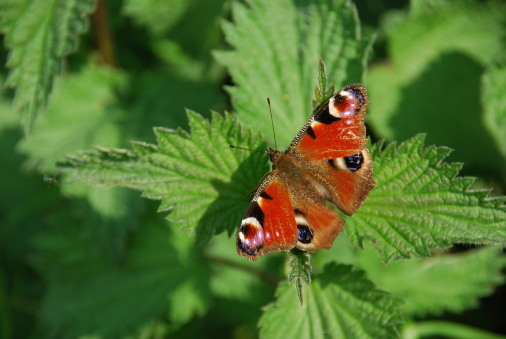Though they are considered by many to be a weed, it seems that many share my attachment to stingers, and this love is expressed through a week dedicated to them. Taking place from 15th – 26th May, Be Nice to Nettles Week is a celebration of these tasty, nutritious and wildlife supporting ‘wonder weeds’.
NETTLES FOR INSECTS
As one of the most important native plants for wildlife in the UK, it’s imperative we care for those clumps of nettles we find in the garden. They do spread like wildfire, so if you don’t fancy them taking over the garden, why not dedicate a little patch or corner and let the nettles run riot? Supporting over 40 species of insects, whose most glamorous members include the tortoiseshell and peacock butterflies, nettles also provide huge quantities of seeds to feed the birds.
FOOD, CLOTHING AND MEDICINE
Throughout history, nettles have been used as a human ally. Now they’re often dismissed as annoying pests because of their sting, but our ancestors used them for clothing, food and medicine. With a rich earthy taste, nettles can liven up soups and stews and provide a nutritional hit of calcium, magnesium, iron and numerous trace elements, as well as a range of vitamins. Nettles were often prescribed as a ‘spring tonic’ to enliven blood, cleanse the body, and help immunity, and they have been used to staunch blood flow from cuts. There is also research into nettles and their help with arthritis. Nettle fibre has been used for centuries to create a cloth which is strong and durable, and there is a revival of interest in nettle cloth because of its ethical and sustainability credentials. The juice has long been used to make dyes too.
Get Involved this Be Nice to Nettles Week!
1. Create a nettle patch in your garden. Not only will it encourage aphid-eating ladybirds, you’ll also welcome a range of other insects and wildlife to your space. Gardeners will find that not only do these plants support wildlife, they also make a nutritious plant fertiliser which can inject your plot with life and help protect against diseases. http://www.nettles.org.uk/nettles/activities/nettlemanure.asp
2. Get experimental with nettles in your food. Pizza toppings, pie fillings, soups, stews, pesto…the list is only limited by your imagination! The River Cottage website http://www.rivercottage.net/recipes/nettle-soup/ has some great ideas.
3. Do the BNTNW wildlife survey. Help workingwithwildlife keep a record of just how many lives these wondrous plants support by joining in with their survey here.
4. Check out the nettle as fibre revolution – the inspiring and amusing John Paul Flintoff describes the history and his own personal discoveries in this Youtube video.
5. Get yourself along to one of the Be Nice to Nettles Week events happening across the UK – find out what’s happening near you here.







